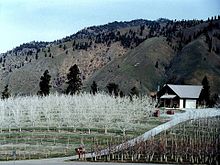Kaolin spray is a pest control that has kaolin as the main ingredient. The practice has been in recorded use from 2000 B.C.E. in China[citation needed]. More recent studies have shown that kaolin sprays can promote photosynthesis and are effective in reducing insects and disease on plants.

Description edit
Kaolin is a rock rich with the clay mineral kaolinite. Kaolin spray is a pest control that has kaolin as the main ingredient.
History edit
In nature, many animal species commonly take "dust baths" to rid themselves of insect parasites and prevent attacks from biting insects.[1] In 2000 B.C.E., records in China describe the application of mineral-based dusts (e.g., diatomaceous earth) to plants to control insects.[2] Subsequently, various mineral-based preparations have been used, and some of these remain in use for agricultural pest control.[3]
More recently, kaolin mixed with spreaders and stickers and applied to plants as a spray at 1–6% concentration in water form has been shown to be an effective approach to agricultural pest control and to protect plants from environmental stresses. Kaolin-based sprays have been studied extensively since 1999 and research has established that these sprays deposit a "particle film" that has numerous beneficial effects on plants and in insect pest control. Certain kaolin-based sprays can form a highly reflective white film over plant surfaces that is known[by whom?] to enhance plant photosynthesis and reduce heat stress in plants, which they do by reflecting the infra-red light spectrum, which in improves plant yields and fruit quality in orchards.[4][5][6] The kaolin barrier created by the particle film also protects the treated plant surfaces from diseases,[7] and insects.[8][9][10][11][12][13]
See also edit
References edit
- ^ Ebling, W. 1971. Sorptive dusts for pest control. Annu. Rev. Entomol. 16:123–158.
- ^ Allen, F. 1972. A natural earth that controls insects. Org. Gardening & Farming 19:50–56.
- ^ Glenn, D., and G. J. Puterka. Particle Films: A new technology for Agriculture. Pp. 1-44. In J. Janick [ed.] HortReviews. Vol.31. John Wiley & Sons, Inc., Hoboken, NJ. 2005.
- ^ Glenn, D.M., G. J. Puterka, S. Drake, T. Unruh, A. Knight, A. Baherle, E. Prado, and T. Baugher. Particle film application influences apple leaf physiology, fruit yield, and fruit quality. J. Am. Soc. Hort. Sci. 2: 175-181. 2001.
- ^ Glenn, D.M., E. Prado, A. Erez, J. McFerson, and G.J. Puterka. A reflective, processed-kaolin particle film affects fruit temperature, radiation reflection, and solar injury in apple. J. Amer. Am. Soc. Hort. Sci. 127:188-193. 2002.
- ^ Glenn, D.M.; S. Drake; J. Abbott; G.J. Puterka, and P. Gundrum (2005). "Season and Cultivar Influence the Fruit Quality Response of Apple Cultivars to Particle Film Treatments". HortTechnology. 15 (2): 249–253. Retrieved November 25, 2015.
- ^ Glenn, D. M., van der Zwet, T., Puterka, G., Gundrum, P., Brown. E. 2001. Efficacy of kaolin-based particle films to control apple diseases. Plant Health Progress doi: 10.1094/PHP-2001-0823-01RS. 2001.
- ^ Puterka, G. J., and D. M. Glenn. Kaolin-Based Particle Films for Arthropod Control. pp. 2075-2080, In (J. L. Capinera, ed.) Encyclopedia of Entomology, Kluwer Academic Publishers. 2008.
- ^ Puterka, G. J., D. M. Glenn, D. G. Sekutowski, T. R. Unruh, and S. K. Jones. Progress toward liquid formulations of particle films for insect and disease control in pear. Environ. Entomol. 29: 329-339. 2000.
- ^ Knight, A. L., T. R.Unruh, B. A. Christianson, G. J. Puterka, and D. M. Glenn. 2000. Effects of a kaolin-based particle film on obliquebanded leafroller (Lepidoptera: Tortricidae). J. Econ. Entomol. 93: 744-749. 2000.
- ^ Unruh, T. R., A. L. Knight, J. Upton, D. M. Glenn, and G. J. Puterka. Particle films for suppression of codling moth (Lepidoptera: Tortricidae) in apple and pear orchards. J. Econ. Entomol. 93: 737-743. 2000.
- ^ Puterka, G. J., Reinke, M., Luvisi, D., Ciomperik, M. A., Bartels, D., Wendel, L., and Glenn, D. M. Particle film, Surround WP, effects on glassy-winged sharpshooter behavior and its utility as a barrier to sharpshooter infestations in grape. Plant Health Progress doi: 10.1094/PHP-2003-0321-01-RS. 2003.
- ^ Puterka, G. J., D. M. Glenn, and R. Pluta. Action of particle films on the biology and behavior of pear psylla (Psyllidae: Homoptera). J. Econ. Entomol. 98: 2079-2088. 2005.